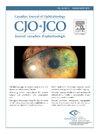Relation between change of effective lens position and toric IOL rotation after toric IOL implantation
IF 3.3
4区 医学
Q1 OPHTHALMOLOGY
Canadian journal of ophthalmology. Journal canadien d'ophtalmologie
Pub Date : 2025-02-01
DOI:10.1016/j.jcjo.2024.05.011
引用次数: 0
Abstract
Objective
To evaluate the relationship between change of effective lens position (ELP) and toric intraocular lens (IOL) rotation in patients with increasing postoperative refractive astigmatism after successful toric IOL implantation.
Methods
The subjects include 61 people (61 eyes) with increasing residual astigmatism >0.5 D 3 months after successful toric IOL implantation. Clinical measurements included preoperative, 1-week, and 1-, 2-, and 3-month postoperative visual acuity; refraction; keratometer; anterior and posterior corneal astigmatism; ELP by Scheimpflug camera imaging; and IOL axis by slit-lamp biomicroscopic photograph with pupil dilation.
Results
Residual astigmatism in postoperative month 3 (0.81 ± 0.50 D) is higher than that at postoperative week 1 (0.41 ± 0.38 D; p < 0.05). ELP decreased by 264.44 ± 163.25 μm, and the IOL rotated by 2.91 ± 1.44 degrees from week 1 to month 3 (p < 0.05). The ELP change had a positive correlation with IOL rotation (R2 = 0.383; p = 0.006), and the postoperative refractive astigmatic change had a positive correlation with ELP change (R2 = 0.272; p = 0.027) and IOL rotation (R2 = 0.272; p = 0.0001) from week 1 to month 3.
Conclusion
ELP change can influence toric IOL rotation and increase residual astigmatism after toric IOL implantation.
Objectif
Évaluer le lien entre une modification de la position effective de l'implant (PEI) et la rotation d'une lentille intraoculaire (LIO) torique chez des patients qui présentent un astigmatisme réfractif postopératoire progressif après l'implantation réussie d'une LIO torique.
Méthodes
L’étude regroupait 61 patients (61 yeux) qui présentaient un astigmatisme résiduel progressif de > 0,5 D 3 mois après l'implantation réussie d'une LIO torique. Les mesures cliniques comprenaient les suivantes: l'acuité visuelle préopératoire et postopératoire (après 1 semaine et après 1, 2 et 3 mois), la réfraction, la kératométrie, l'astigmatisme cornéen (antérieur et postérieur), la PEI mesurée par imagerie Scheimpflug et l'axe de la LIO mesuré par photographie au biomicroscope (lampe à fente) dans le cadre d'un examen dilaté.
Résultats
L'astigmatisme résiduel mesuré 3 mois après l'intervention (0,81 ± 0,50 D) était plus prononcé que celui qui avait été mesuré 1 semaine après l'intervention (0,41 ± 0,38 D; p < 0,05). La PEI a diminué de 264,44 ± 163,25 μm, et la LIO a subi une rotation de 2,91 ± 1,44 degrés entre la première semaine et le troisième mois après l'intervention (p < 0,05). On a observé une corrélation positive entre la variation de la PEI et la rotation de la LIO (R2 = 0,383; p = 0,006), de même qu'une corrélation positive entre la modification de l'astigmatisme réfractif postopératoire et la variation de la PEI (R2 = 0,272; p = 0,027), d'une part, et la rotation de la LIO (R2 = 0,272; p = 0,0001), d'autre part, entre la première semaine et le troisième mois après l'intervention.
Conclusion
La variation de la PEI peut agir sur la rotation des LIO toriques et accroître l'astigmatisme résiduel après l'implantation de ce type de lentille.
散光人工晶体植入术后有效晶状体位置变化与散光人工晶体旋转之间的关系
目的探讨人工晶状体植入术后屈光散光加重患者晶状体有效晶状体位置(ELP)变化与晶状体旋转的关系。方法选择人工晶状体植入术3个月后残余散光增加0.5 D的患者61例(61眼)。临床测量包括术前、术后1周、术后1、2、3个月的视力;折射;角膜散光计;前、后角膜散光;Scheimpflug相机成像ELP;瞳孔扩张的裂隙灯生物显微照片。结果术后第3个月残余散光(0.81±0.50 D)高于术后第1周(0.41±0.38 D);p & lt;0.05)。ELP下降264.44±163.25 μm, IOL从第1周到第3个月旋转2.91±1.44度(p <;0.05)。ELP变化与人工晶状体旋转呈正相关(R2 = 0.383;p = 0.006),术后屈光散光变化与ELP变化呈正相关(R2 = 0.272;p = 0.027)和人工晶状体旋转(R2 = 0.272;P = 0.0001)从第1周到第3个月。结论elp的改变会影响人工晶状体的旋转,增加人工晶状体植入术后的残余散光。ObjectifÉvaluer le lien entre une modification de la position effective de l'implant (PEI) et la rotation d'une lentile intraocular (LIO) torque, des patients quatime samsamement,散光,samatime, samatime, samatime, samatime, samatime, samatime, samatime, samatime。MethodesL 'etude regroupait 61名患者(61眼眸),presentaient联合国astigmatisme而是progressif德比;[0,5] [D] [D] [D] [D] [D] [D] [D] [D] [c]。Les措施倩碧comprenaient Les遵循:l 'acuite visuelle preoperatoire et postoperatoire(然后1 semaine然后1、2等3月),折射,la keratometrie l 'astigmatisme corneen (anterieur et posterieur),拉裴mesuree par imagerie Scheimpflug et l 'axe de la LIO序par photographie盟生物显微镜(兰佩fente)在干部d一个反省扩张。rs - sultats1 ‘像散度rs - samuestil ’intervention(0,81±0,50 D) - samuestil 'intervention(0,41±0,38 D);p & lt;0 05)。La PEI a subi one rotation de 2,91±1,44 degracry entre La premiires semaine et le troisi mois apr s l'intervention (p <;0 05)。在一个观测值上,有一个正的校正中心,即变异和旋转(R2 = 0,383;p = 0,006),de même qu'une corcorsiation positive entre la modification de l'astigmatisme racfractif postopsamatoire et la variation de la PEI (R2 = 0,272;p = 0,027),d'une part, et la rotation de la LIO (R2 = 0,272;P = 0,0001),d'autre part, entre la premiires semaine et le troisiires mois aprires l'intervention。结论:瞳孔瞳孔的变异与瞳孔瞳孔的旋转有关,瞳孔瞳孔的散光与瞳孔瞳孔的旋转有关,瞳孔瞳孔的植入与瞳孔类型有关。
本文章由计算机程序翻译,如有差异,请以英文原文为准。
求助全文
约1分钟内获得全文
求助全文
来源期刊
CiteScore
3.20
自引率
4.80%
发文量
223
审稿时长
38 days
期刊介绍:
Official journal of the Canadian Ophthalmological Society.
The Canadian Journal of Ophthalmology (CJO) is the official journal of the Canadian Ophthalmological Society and is committed to timely publication of original, peer-reviewed ophthalmology and vision science articles.

 求助内容:
求助内容: 应助结果提醒方式:
应助结果提醒方式:


